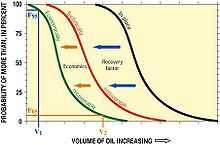Proven reserves

Proven reserves, also called proved reserves, measured reserves, 1P, and Reserves, are business or political terms regarding fossil fuel energy sources. (see prove: usage). They are defined as a "Quantity of energy sources estimated with reasonable certainty, from the analysis of geologic and engineering data, to be recoverable from well established or known reservoirs with the existing equipment and under the existing operating conditions."[1] These terms relate to common fossil fuel reserves such as oil reserves (see main article), natural gas reserves, or coal reserves.
Operating conditions includes operational break-even price, regulatory and contractual approvals, without which these items cannot be classified as proven and are usually classified into probable. Price changes therefore can have a large impact on classification of proven reserves. Regulatory and contractual conditions may change, and also affect proven reserves amount.
Numbered terms
The engineering term P90 refers to 90 percent engineering probability, is a commonly accepted specific definition by Society of Petroleum Engineers, it does not take into account anything except technical concerns. Therefore, it is different from the business term which does take into account current break-even profitability, and regulatory and contractual approval, but is considered a very rough equivalent. The definition is certainly not universal. Energy Watch Group uses a different definition, P95.
More terms
Disregarding economics, the proper engineering term for the total technologically extractable amount is the Producible fraction, which is easily confused with the business/political term proven reserves. However, the purely engineering term is also misleading in that squeezing the last bits of fossil fuel out follows the diminishing returns and at some point is so costly that it becomes highly impractical, as seen on a bell curve, which is why measures like P90 and P95 were created. The term proven reserves is further subdivided into proved developed reserves and proved undeveloped reserves. Note that it DOES NOT include Unproven reserves, which is broken down into probable reserves as well as possible reserves - which are those reserves that only have a 10% likelihood of being recoverable.[2]
These reserve categories are totalled up by the measures 1P, 2P, and 3P, which are inclusive, so include the previous safer measures as:
- "1P reserves" = proven reserves (both proved developed reserves + proved undeveloped reserves).
- "2P reserves" = 1P (proven reserves) + probable reserves, hence "proved AND probable."[3]
- "3P reserves" = the sum of 2P (proven reserves + probable reserves) + possible reserves, all 3Ps "proven AND probable AND possible."[4]
Russian reserve categories
In Russia, reserves categories A, B, and C1 correspond roughly to proved developed producing, proved developed nonproducing, and proved undeveloped, respectively; the designation ABC1 corresponds to proved reserves. The Russian category C2 includes probable and possible reserves.[7]
Reserves growth may also occur due to technological changes, economic changes, and even geological changes and the passage of time (decades) as settling occurs.
Reserve evaluations, valuations and certifications
Oil companies employ specialist reserve valuation consultants - such as Sproule, DeGolyer and MacNaughton, Ryder Scott, Netherland, Sewell & Associates Inc. (NSAI) and others - to provide third party reports as part of Securities and Exchange Commission (SEC) SEC filings. On December 30 2009, recognising advances in exploration and valuation technology, the SEC allowed 2P probable and 3P possible reserves to be reported, along with 1P proved reserves, though oil companies also have to verify the independence of third party consultants. Since investors view 1P reserves with much greater importance than 2P or 3P reserves, oil companies seek to convert 2P and 3P reserves into 1P reserves.[8]
See also
References
- ↑ Business Dictionary Proved Reserves
- ↑ RWE Deposits and extraction of Natural Gas
- ↑ Petroleum review: 62 p732-743 Institute of Petroleum (Great Britain) - 2008 "The field is estimated to hold some 66mn barrels of proved and probable (2P) oil reserves and 143mn barrels of proved, probable and possible (3P) reserves. "
- ↑ Offshore Oil Industry Lexicon 2-1 3P RESERVES Proven, Probable plus Possible reserves (3P) are those reserves that , to a low degree of certainty (10% confidence), are recoverable. There is relatively high risk associated with these reserves.
- ↑ Vivek Chandra Fundamentals of natural gas: an international perspective 2006 p20 "Probable reserves are unproved reserves that analysis of geological and engineering data suggests are likely to be ... exceed the sum of proved plus probable plus possible reserves, also known as “P + Probable + Possible = 3P” reserves. "
- ↑ Energy, Environment and Development p55 José Goldemberg, Oswaldo Lucon - 2009 "3P): reserves that have about 10 per cent probability of exploitation, under favourable circumstances."
- ↑ Society of Petroleum Engineers, SPE Reserves Committee,
- ↑ Gianna Bern Investing in Energy: A Primer on the Economics of the Energy Industry 2011 p55 "Similarly, producers will try to convert their 2P reserves into 1P reserves by virtue of the certification process, which we will ... Bankers, investors, and analysts view 1P reserves with much greater importance than 2P or 3P reserves. ..."
| |||||||||||